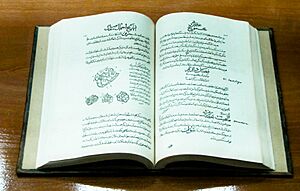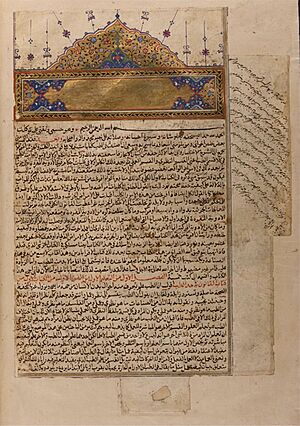The Canon of Medicine facts for kids

Persian version of The Canon of Medicine at Avicenna's mausoleum in Hamedan
|
|
| Author | Avicenna |
|---|---|
| Original title | القانون في الطب |
| Language | Arabic |
| Genre | Medical literature |
| Published | 1025 (Arabic) |
The Canon of Medicine (Arabic: القانون في الطب, romanized: al-Qānūn fī l-ṭibb) is a huge medical book written by a brilliant Muslim Persian doctor and thinker named Avicenna. He finished this amazing work in 1025. It's one of the most important books from its time.
This book brings together all the medical knowledge from the Islamic world back then. It was influenced by older medical traditions. These included medicine from ancient Greece and Rome, especially the ideas of Galen. It also took ideas from Persian, Chinese, and Indian medicine.
When The Canon of Medicine was translated from Arabic into Latin in the 12th century, it changed medicine in Europe a lot. It became the main textbook for teaching doctors in European universities for hundreds of years. People used it as a standard medical guide until the 18th century! It's still an important text in Unani medicine, which is a traditional healing system used in India.
What's in a Name?
The English title, Canon of Medicine, comes from the Latin name Canon Medicinae. This Latin name was a translation of the original Arabic title, القانون في الطب. All these names mean the same thing.
The word "Canon" here means an organized system or a complete, all-around collection of knowledge. Think of it like a set of rules or a full encyclopedia. The book was often called Liber Canonis in the Middle Ages.
How the Book Was Created
For a long time, Islamic medicine was mostly based on the ideas of doctors like Galen and Hippocrates. Avicenna wanted to combine these medical ideas with the natural philosophy of Aristotle.
Avicenna started writing The Canon of Medicine in a city called Gorganj. He kept working on it in Rey and finally finished it in Hamadan in 1025. The book became a clear and organized summary of all the medical knowledge known in Avicenna's time. It was much shorter and easier to use than Galen's twenty volumes of medical writings.
What's Inside the Canon?
The Canon of Medicine is divided into five main books:
- Book 1: This part talks about the basic rules of medicine and how the body works. It covers anatomy (how the body is built), healthy living, and general ways to treat sickness.
- Book 2: This book lists many different medical substances, like herbs and medicines. They are listed in alphabetical order. It also explains what these substances generally do.
- Book 3: This section focuses on how to find and treat diseases that affect only one specific part of the body.
- Book 4: This part deals with illnesses that affect many parts of the body or the whole body. It explains how to diagnose and treat them.
- Book 5: This final book is like a recipe book for medicines. It contains formulas for making different compound remedies (medicines made from several ingredients).
Books 1, 3, and 4 are further divided into smaller sections. These include parts called fanns, chapters called ta’līms, subchapters called jumlahs, sections called faṣls, and even smaller subsections called bābs.
See also
- Al-Tasrif
- Medical literature
- The Book of Healing
- Al-Nijat


